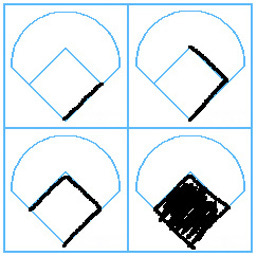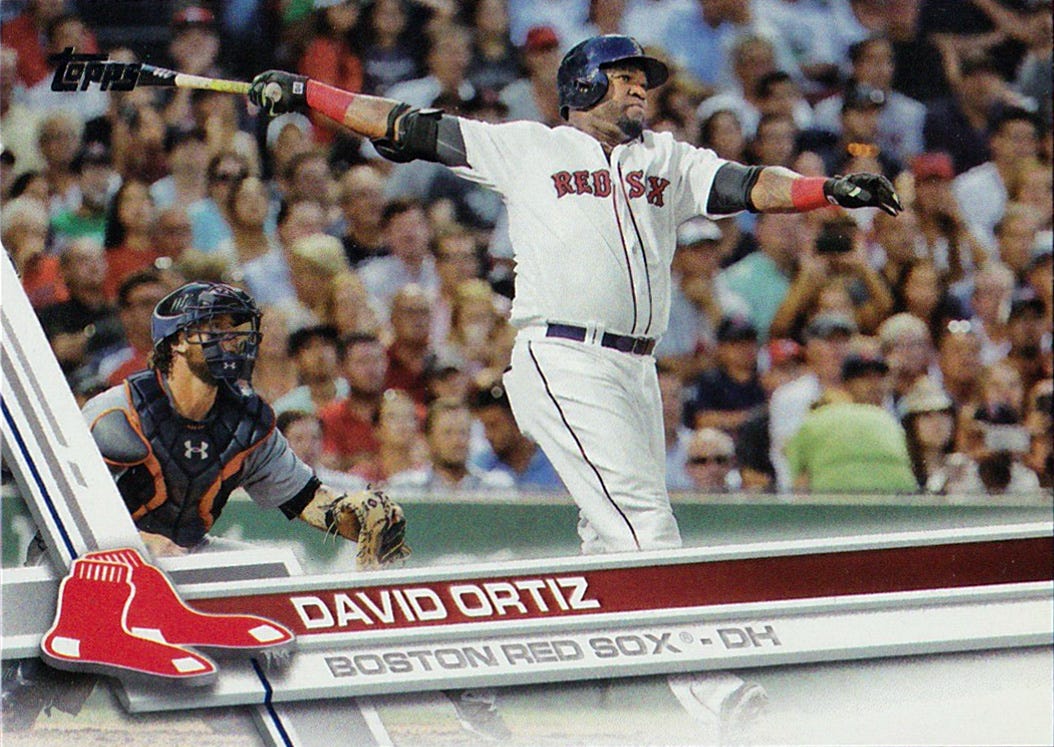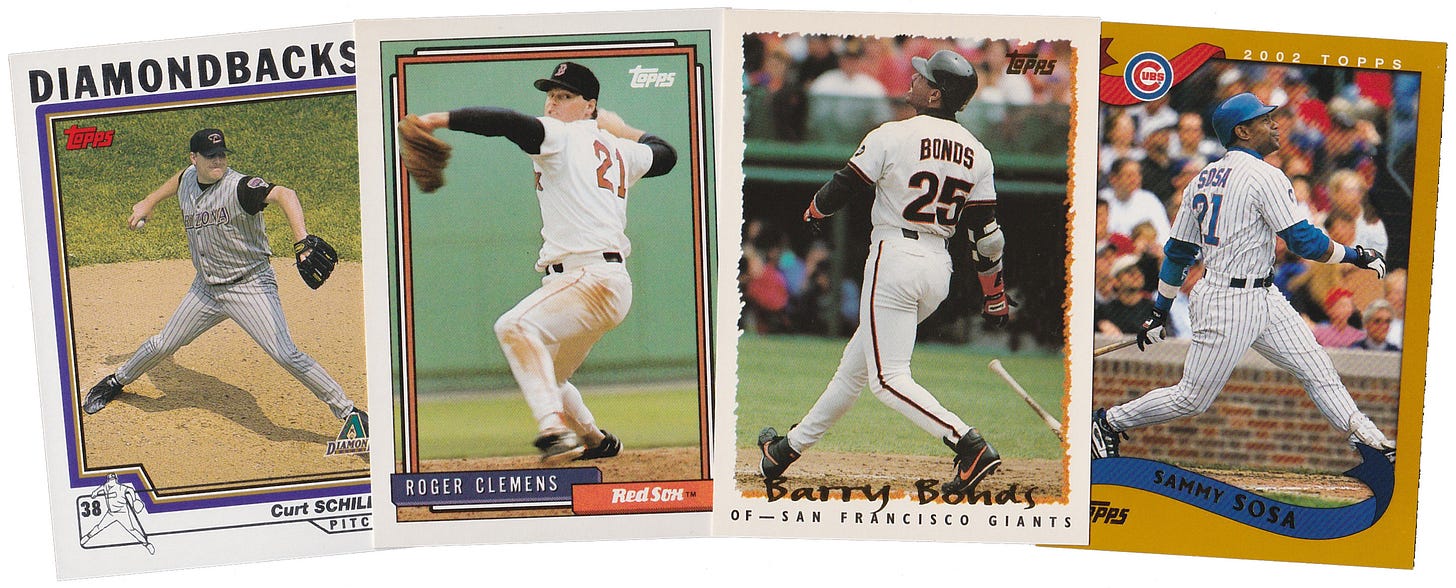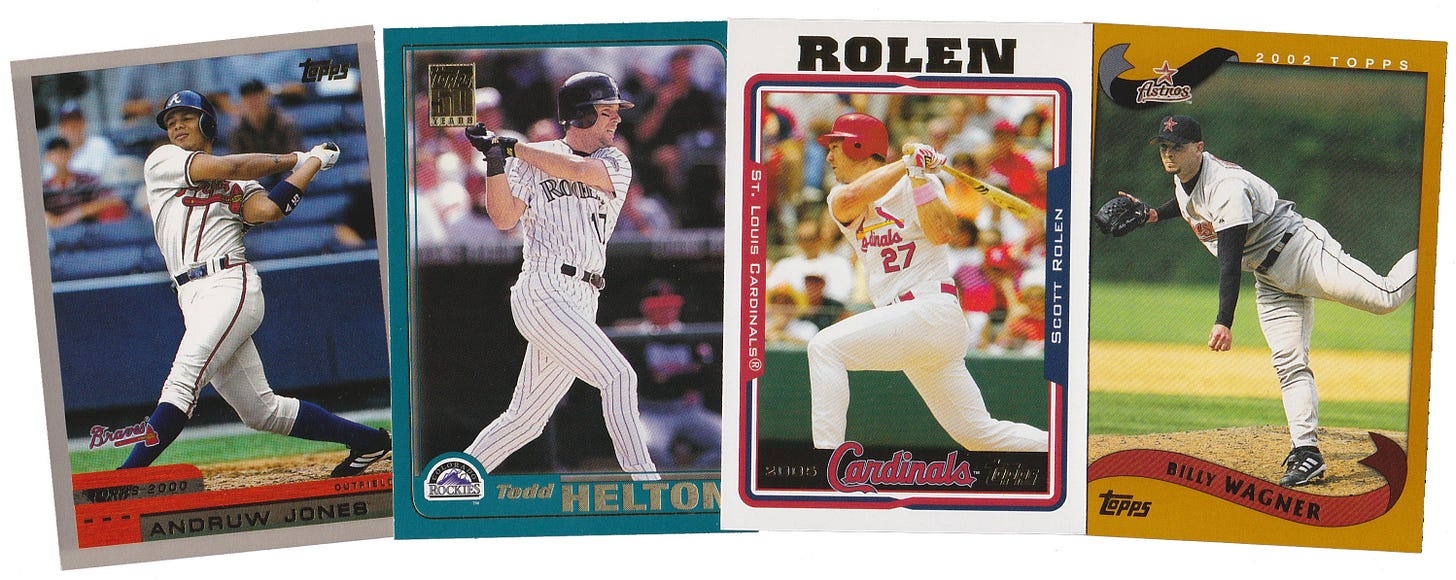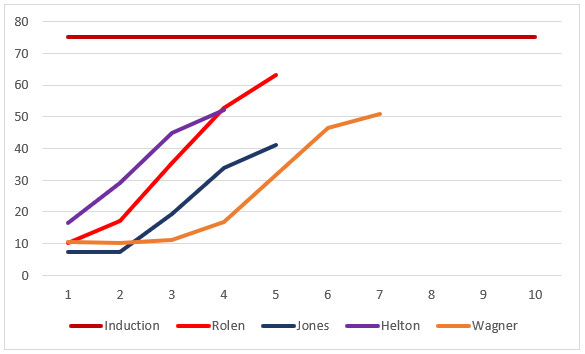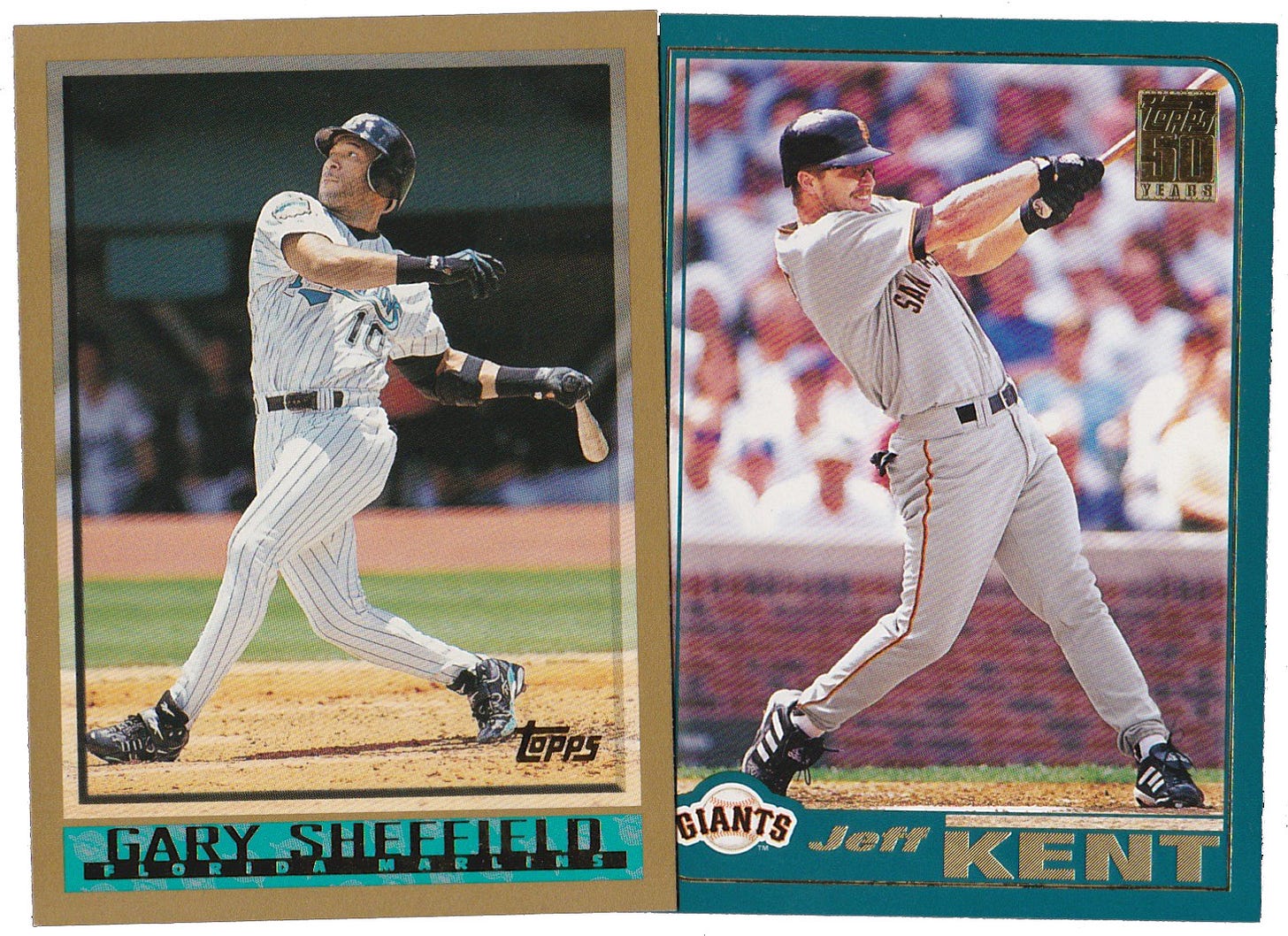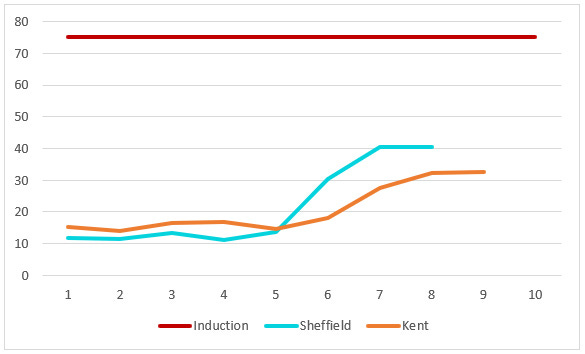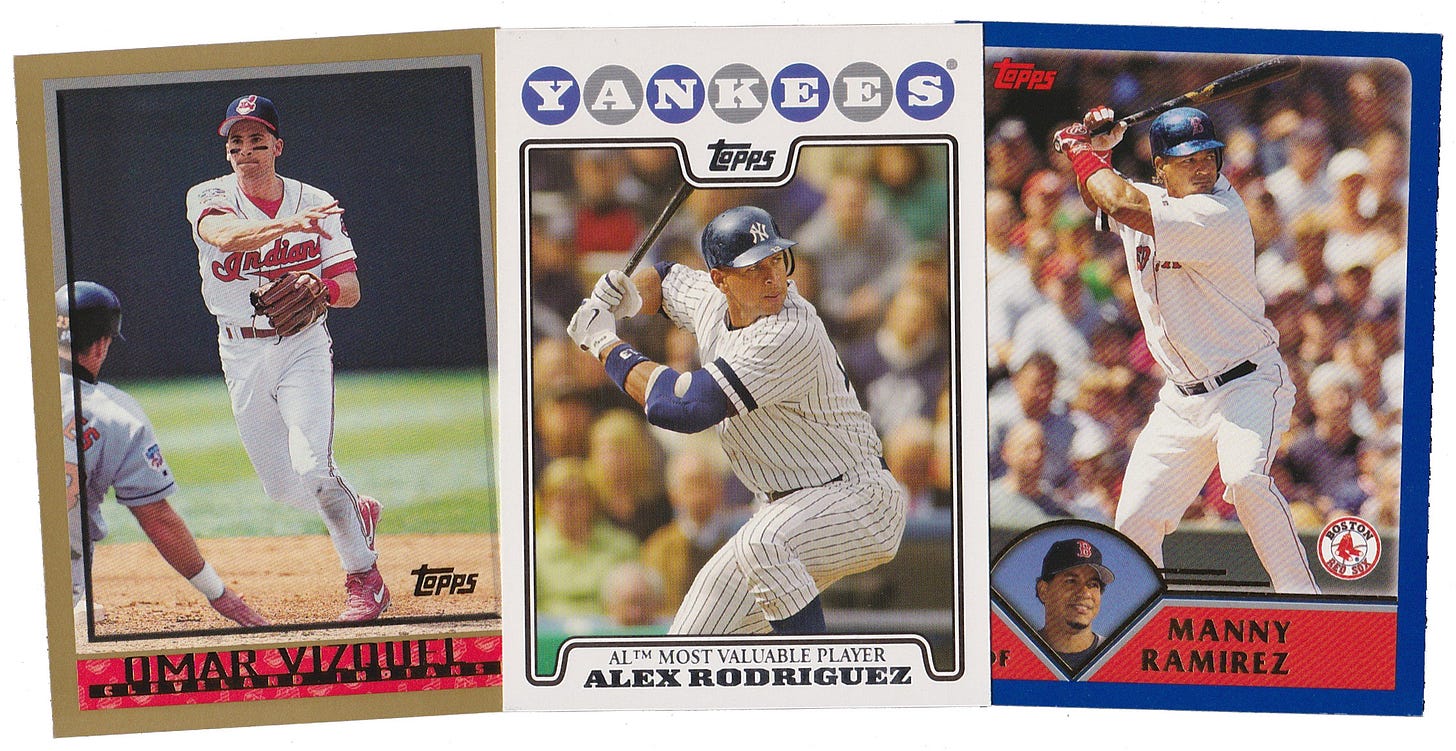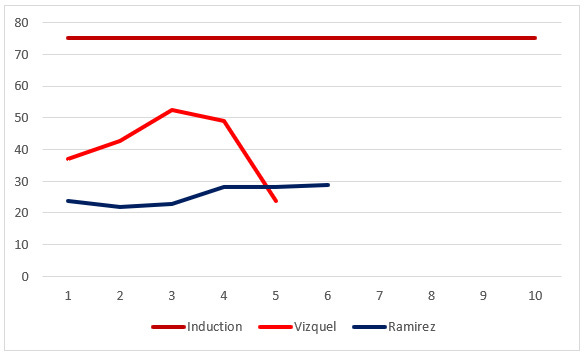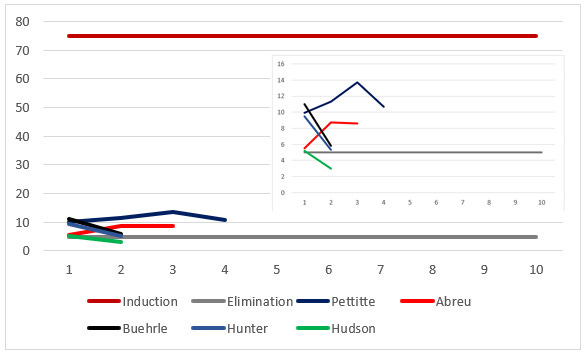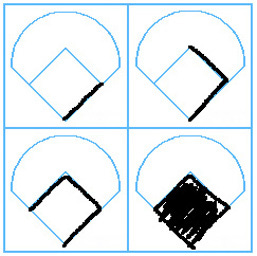The Cycle, Issue 117: Re-Cycle
Parsing the Hall of Fame vote, checking in on the labor talks, and gearing back up for Year Two of The Cycle
In this issue of The Cycle . . .
Housekeeping: The Cycle: Year Two
The Hall of Fame: Parsing the BBWAA ballot results
Labor Pains: Checking in on the lockout
Feedback
Closing Credits
The Cycle: Year Two
We’re back! Thank you so much for your patience and continued interest in The Cycle, as we officially move into the second year of the newsletter. The first issue of The Cycle was sent out to subscribers on January 25 of last year, making this past Tuesday The Cycle’s first birthday. Exactly one year ago today, I published the second issue, a deep dive into last year’s Hall of Fame voting results, and I’ll get to this year’s version of that after this brief preamble, thus validating the intentionally cyclical nature of this newsletter.
Before we get to the meat of the matter, however, I wanted to take a moment to let you know what to expect from The Cycle this year. The trick is, I’m not really sure what to expect, myself. Part of that is due to the uncertainty resulting from Major League Baseball’s work stoppage, which has me heading into a third year of professional uncertainty, full stop.
The other is that, the only thing I know for sure about Year Two of The Cycle is that I won’t be able to keep up the pace I established in Year One. That might mean the newsletter remains weekly for the entire year, rather than returning to the thrice-weekly schedule I kept through mid-November last year. It will almost certainly mean scaling back the length of the individual issues, regardless of their frequency.
At the moment, I intend to achieve shorter issues simply by trying to be less of a completist, particularly when it comes to injuries, transactions, and obituaries. That doesn’t mean I won’t cover those things, but I will try to pick my spots a bit more. The good news there is that I continue to write the free, daily MLBTR Newsletter for MLB Trade Rumors. I don’t go into depth on every news item in that newsletter, but I do add my two cents about things as I go, so if you want a way to get daily baseball news lightly seasoned by my commentary, you can subscribe via the button on the MLBTR sidebar and receive it free to your inbox Monday through Friday. It usually lands late morning, Eastern Time, and tends to be between 1,000 and 2,000 words in length (by comparison, some issues of The Cycle have exceeded 10,000 words. Today’s is about 5,000 words).
One of the writing tricks I’ve learned over the years is that, rather than trying to put some essay-style conclusion on everything, sometimes the best way to end a piece is to just stop when you have nothing else to say. I’m going to try to apply that philosophy, in a way, to the newsletter. That is to just stop when there’s already enough there and I can feel the angle of the slope increasing. For example, my initial outline for today’s issue included a Newswire section rounding up the top stories from the seven weeks during which The Cycle was on hiatus. In the interest of my sanity, health, and ability to actually get this issue to you in a timely manner, I cut that section. That might be a sign that, if nothing else, I’m smarter today than I was a year ago, or maybe just a bit more clear-minded.
Given the uncertainty I just described, I’m keeping paid subscriptions paused for now. Today’s issue is free to all, and I suspect the next will be, as well. Those of you who have paid for subscriptions still have equity for when I flip that switch back on, the delay merely extends the length of your subscription. In that way, it’s just like the last month or so, except you’ll now be getting weekly issues again without being charged for them. New readers are still able to sign up for free subscriptions (just click that button below), and will have the option to upgrade to paid subscriptions when I flip that switch. For now, let’s just ease back into things.
Once again, I thank all of you very much for reading, subscribing, and otherwise supporting The Cycle. As much work as I created for myself last year, it was a real joy to experience the baseball season with you all via this newsletter, and I look forward to what this year will bring for both MLB and The Cycle.
The Hall of Fame
Per the Baseball Writers’ Association of America’s announcement on Tuesday, David Ortiz has been elected to the National Baseball Hall of Fame, thus becoming the first, and only, player in two years to be elected by the writers. And just barely, at that.
Ortiz was named on 307 of the 394 ballots submitted, just 11 more than the minimum number required to reach the 75 percent threshold for induction. Meanwhile, just two other first-year players surpassed the five percent required to remain on the ballot (Alex Rodriguez at 34.3 percent and Jimmy Rollins at 9.4 percent), while one returning player fell below that minimum (Tim Hudson, three percent), and four others (Barry Bonds, Roger Clemens, Curt Schilling, and Sammy Sosa) saw their 10 years on the ballot expire. After Ortiz, the next-highest share of the vote was Bonds’s 66 percent, which left him 36 votes shy of induction.
The above would all seem to signal a continued lack of enthusiasm on the part of the writers for the players currently on the ballot, but, as is always the case in the Hall of Fame voting, there were more Hall of Famers on this ballot than were inducted this year, and I don’t just mean that as a platitude. I believe that, at absolute minimum, four other players from the 2022 ballot will be inducted into the Hall of Fame in the next 10 years, and at least three of them will be elected by the writers.
Exactly one year ago today, in parsing the results of last year’s writers’ ballot, which saw no player elected to the Hall, I pointed out that, in 2013, the last time the writers failed to elect anyone, the ballot in question contained nine players (so far) who would eventually be inducted, and we’re not even 10 years removed from that ballot yet. This is always how the Hall voting has gone. There are always more future Hall of Famers on any given ballot than are elected in that particular year. So, with that in mind, lets dive into this year’s down-ballot results to see what we can learn about the future Hall of Fame chances of the other 29 candidates.
Note: I am a member of the BBWAA but not yet eligible to vote for the Hall of Fame.
The First-Ballot Hall of Famer
First a few words on David Ortiz. Don’t sweat his mere 77.9 percent of the vote. In recent years, Larry Walker (76.6), Mike Mussina (76.7), and Iván Rodríguez (76.0) each received a lower vote share in their induction year, and only Rodríguez did so on his first try. For players with significant support, vote totals almost always rise over time. If the cutoff was 80 percent, Ortiz likely would have been inducted next year. If it was 85, perhaps in two years. All that matters is that Ortiz is in, and I, for one, believe he is fully deserving of the honor. I broke down his candidacy in Issue 114, but here’s the key bit:
In his 14 years with the Red Sox, Ortiz hit .290/.386/.570 (148 OPS+), averaging 34 homers, 81 walks, 37 doubles, 109 RBI, and just 101 strikeouts per season. He made 10 All-Star games, won seven Silver Sluggers, and was top-6 in the MVP voting six times, including top five every year from 2003 to 2007. On top of all of that, he hit .289/.404/.543 in 369 postseason plate appearances, with another 17 homers, 59 walks, 22 doubles, and 61 RBI. He delivered some of the most memorable postseason moments of the 21st century, was the MVP of the 2004 ALCS (a series in which he had two walk-off hits), the MVP of the 2013 World Series, and hit .455/.576/.795 [yes, really] in 59 World Series plate appearances in the process of bringing three championships to a Red Sox franchise that hadn’t won one for 86 years before his arrival. He finished his career with 541 homers and 2,472 hits, and likely could have kept going. At the age of 40, he hit .315/.401/.620 (164 OPS+) in 626 plate appearances, one of the greatest final years in major-league history.
David Ortiz was an iconic player essential to the story of baseball over first two decades of the new century, and he has been a great ambassador for the sport since his playing days. Like Mariano Rivera, he was the rare player who transcended the Yankees–Red Sox rivalry, earning respect and even affection from both sides. There is no doubt in my mind that David Ortiz should be inducted into the Hall of Fame, and he is the one player on this year’s ballot who I think has a good chance to cross the 75 percent threshold for induction, though he may not do so by much.
Nailed it. Next!
One and Done
Let’s start with the players who have fallen off the ballot and thus clearly have no route into the Hall as a non-tourist other than via the Eras Committees. In my preview of this ballot, I listed eight players as no-doubt one-and-done candidates. All fulfilled that destiny, as did two others, Mark Teixeira and Joe Nathan, who I listed as more compelling first-year candidates. A surprising number of those players picked up votes, however, so let’s give them their due by listing them with their vote totals (20 votes were required to reach five percent this year and remain on the ballot): Joe Nathan (17), Tim Lincecum (9), Ryan Howard (8), Mark Teixeira (6), Justin Morneau (5), Jonathan Papelbon (5), Prince Fielder (2), A.J. Pierzynski (2), Carl Crawford (0), Jake Peavy (0).
In 2020, Ted Simmons, who was one-and-done on the writers’ ballot in 1994, was elected to the Hall of Fame by the Modern Baseball Committee. Simmons received just 17 votes in ’94, a year that 23 were required to remain on the ballot. Might any of this year’s crop of one-and-done players eventually find their way into the Hall? I continue to believe that Nathan and Teixeira are the most deserving of that bunch, but the vote suggests that Lincecum and Howard could also win over a small group of committee voters a couple of decades from now.
Over and Out
Unfortunately, most of the discussion I have seen thus far regarding the results of this ballot has focused not on the one player that got in, but on the small cohort whose 10 years on the ballot has elapsed. That group just happens to include one of the best hitters and one of the best pitchers in the history of the game. As I mentioned above, in his tenth and final try, Barry Bonds fell 36 votes shy of induction, Roger Clemens fell 39 votes shy, Curt Schilling fell 65 votes shy, and Sammy Sosa, well, Sammy never got close. Here’s what their ten years on the ballot looked like:
Schilling sabotaged his own candidacy with his vile, violent, and seditious public discourse. He was well on his way to induction before he decided it was a good idea to share his approval of a t-shirt that joked about lynching journalists ahead of the 2016 vote (that’s his year-five dip above). His candidacy recovered from that offensive tweet, only for Schilling to go fully off the deep-end into dangerous, damaging, and hateful right-wing conspiracy theories, spreading lies about school shootings and cheering on the January 6 insurrectionists, among other things that went far beyond political opinion or activism and into the realm of hate speech and sedition.
I believe that more than 75 percent of the BBWAA’s Hall voters believe Schilling had a Hall of Fame pitching career, but enough of them were unwilling to give him a platform to continue to spout his harmful rhetoric that he fell well short of induction, shedding 54 votes in his final year on the ballot relative to 2021. If I had a vote, I would have been in that group. Perhaps Schilling’s candidacy will one day come before a committee that is less disturbed by the things he has said and is likely to say, but, if my vote was the deciding factor, Schilling would have two routes to the Hall of Fame: genuine, heartfelt, public contrition and apology, or posthumous induction.
As for Sammy Sosa, despite his brilliant peak, he had was a borderline candidate (shy of the JAWS standard for right fielders) widely suspected of using performance-enhancing drugs. Though the evidence linking Sosa to PEDs is circumstantial, at best, the combination of those suspicions and his borderline status rendered him an also-ran with the writers. The 18.5 percent of the vote he received this year was his highest share in his 10 years on the ballot.
Which brings us to Barry Bonds and Roger Clemens. They looked like they might be on pace for induction around year five of their candidacies, but their gains leveled out from there. Still, their support continued to increase, as both received their highest vote share in this, their final year on the ballot (66 percent for Bonds, 65.2 for Clemens).
In 2014, the Hall of Fame (not the writers, it should be noted) reduced the duration of an eligible player’s time on the writers’ ballot from 15 years to 10. That was just prior to Bonds and Clemens’s third year on the ballot. At the time, the move was widely viewed as taking direct aim at Bonds and Clemens’s candidacies, reducing the period of time they would have to reach the 75-percent threshold via the thawing of the writers’ opinions about their alleged PED use and the acquisition of the vote by a younger generation of writers less likely to hold those allegations against them.
The verdict this week is that the rule change worked as intended. I have no doubt that, given another five years, both Bonds and Clemens would have been elected by the writers, joining the likes of Bert Blyleven (14 years), Jim Rice (15 years), Bruce Sutter (13 years), Duke Snider (11 years), Bob Lemon (14 years), and Ralph Kiner (15 years), just to name some of the Hall of Famers who required more than 10 years on the writers’ ballot to be elected.
As to the chances of any of these four gaining induction via the Eras Committees, my general impression is that the members of those committees, as a group, take greater offense to alleged PED use than to Schilling’s more verifiable extracurricular transgressions. Thus, I think Schilling may have the best chance. I’ll be very curious to see if any of the other three even get nominated to an Eras Committee ballot.
Okay, now for the fun stuff . . .
The Future Hall of Famers
Scott Rolen, who gained 37 votes this year, increasing his vote share to 63.2 percent, is going to be elected to the Hall of Fame by the writers, likely next year. Todd Helton, who gained 25 votes to climb to 52 percent in his fourth year on the ballot, will likely follow a year or two after.
Andruw Jones and Billy Wagner have further to go in less time, but, with the ballot thinning out after this year, I feel confident that Jones will get there before his 10 years expire. Wagner will be a closer call. He has just three years of eligibility remaining and only gained 15 votes this year. However, all four of these candidates have the opportunity to make a big jump next year.
On next year’s ballot, Bonds, Clemens, Schilling, and Sosa will all be gone, with only Alex Rodriguez to replace them (while Jimmy Rollins subs in for Tim Hudson). The only first-year candidate who will draw a significant share of the vote is Carlos Beltrán, who comes with his own baggage given his central role in the 2017 Astros’ sign-stealing scandal and whom many considered a borderline candidate to begin with. Francisco Rodriguez might clear five percent, as well, but no other 2023 first-timer will. Remember, at least 260 writers voted for at least one of Bonds, Clemens, Schilling, or Sosa this year, and the four received a total of 821 votes. Many of those writers also voted for Rolen, Helton, Jones and/or Wagner, but there will still be a lot of room on the ballots of big-Hall voters next year that was not there this year.
After 2023, it gets tougher for the holdovers. There are deep, impressive classes of first-timers in both 2024 and 2025, while only Kent and Sheffield are due to expire from the ballot due to the 10-year limit during those years. The 2024 ballot will introduce likely Hall of Famers Adrían Beltré, Joe Mauer, and Chase Utley, and a few other players with a chance to clear five percent, including David Wright, Matt Holliday, Bartolo Colon, and José Bautista. The 2025 ballot will mark the debuts of slam-dunk first-ballot Hall of Famer Ichiro Suzuki, borderline candidates CC Sabathia, Dustin Pedria, and Ian Kinsler, and Hall of Fame talents Félix Hernández (assuming he doesn’t make another comeback attempt in the interim), and Troy Tulowitzki.
Rolen should go in before that deluge, and Helton and Jones can outlast it. Wagner could be swept away by it, but if he builds enough momentum next year, he just might yet break through it. If not, he’s likely to have enough momentum coming off the writers’ ballot to be a Lee Smith–like, quick-turn-around Eras Committee inductee.
Too Little Too Late
After five years with little movement, Jeff Kent and Gary Sheffield finally started to make some gains on recent ballots, but both plateaued this year, and, with just one and two years of eligibility remaining, respectively, they simply don’t have enough time to get to 75 percent. On the Eras Committees, Kent is likely to fair better because he doesn’t have Sheffield’s PED associations, but both were regarded as abrasive personalities during their careers and may struggle for sufficient support in that more fraternal context.
Purgatory
Omar Vizquel has had one of the most unique Hall candidacies in recent memory, rivaled only by Schilling in its volatility and repulsiveness. Vizquel hit the ballot as a divisive candidate because, as I wrote in Issue 114:
Old school voters saw 2,877 hits, 11 Gold Gloves, and a 24-year career and figured he was an easy yes. Stat-friendly voters saw an all-glove, no-bat player who posted a career 82 OPS+, only once surpassed 4.0 bWAR in a season, and ranked between Mark Bellinger and Rico Petrocelli in JAWS and figured he was an easy no.
Then, just before the 2020 ballot was released, allegations of domestic abuse surfaced and bent his curve. With an extra year to digest those allegations, the writers’ support for Vizquel has plummeted. He lost 103 votes between 2020 and 2021 and is down 115 votes relative to his peak in 2019. Per FiveThirtyEight’s Nathaniel Rakich, Vizquel’s 25.2-point drop this year was the largest single-year decline in voter support in the modern history of the writers’ ballot. With just five years remaining and a votership that is increasingly comprised of writers who didn’t think he was a Hall of Famer before the domestic abuse story broke, I can’t see how he gets into the Hall via the writers’ ballot.
Manny Ramirez was twice suspended by Major League Baseball for performance-enhancing drug use, a line in the sand that even many Bonds-and-Clemens voters would not cross. He was clearly a Hall-quality hitter, by the numbers, but he has no momentum and will not be elected to the Hall by the writers.
Alex Rodriguez, who debuted this year with 34.3 percent of the vote, is a nearly identical case to Ramirez. Twice found in violation of the league’s PED policy, he is a slam-dunk Hall of Famer on paper who will never go in via the pages submitted by the writers. I expect him to flatline much like Ramirez has, though next year’s thin ballot could give him an illusory one-year bump.
Just Happy to Be Here
Tim Hudson fell below five percent in his second year on the ballot, so he’s not even here. The other players here are just barely hanging on. Torii Hunter had just one vote to spare in this, his second year on the ballot. Mark Buehrle had just three. Bobby Abreu and Andy Pettitte, who are a bit more secure about sticking around, have no momentum. Jimmy Rollins slots in with this this group in this, his first year on the ballot, coming in at 9.4 percent with three more votes than Abreu and five less than Pettitte. He should stick around for a few years, but it remains to be seen if he can build any momentum. I don’t tend to think of Rollins a Hall of Famer, but I do think he deserves the longer look the voters appear willing to give him and will be curious to see if Utley’s appearance on the ballot in two years helps or hurts his candidacy.
Thus ends this year’s Hall of Fame discourse, at least in this space (unless you have unanswered questions you’d like me to address). Ortiz and the six Eras Committee inductees—Tony Olivo, Jim Kaat (both living), Buck O’Neil, Minnie Miñoso, Gil Hodges, and Bud Fowler (all posthumous)—will be inducted in late July. Curiously, the three living inductees are all former Twins, but only two of them will go in with an interlocking “TC” on their cap.
Labor Pains
The penultimate issue of The Cycle in 2021 came two days after the owners decided to lock out the players, creating the first work stoppage in Major League Baseball since the conclusion of the 1994–95 strike. Since then, not much has happened, particularly on the labor front. The two sides met in person on December 16 to discuss what were described as non-economic issues (PED policies, the joint domestic-violence/sexual-assault/child-abuse policy, procedures for filing grievances, scheduling, special events). They didn’t meet again until January 13, when the owners made a proposal to the union via video chat. The union didn’t respond with its counterproposal until this past Monday, January 24, but that meeting was in person, and the owners responded the next day. The two sides are currently working on some ancillary issues, and the union is expected to make its next major counterproposal early next week.
That is to say, at long last, they are finally talking, and while the two sides remain very far apart on the core economic issues that threaten to push back Spring Training and delay the start of the regular season, they do appear to be making some degree of progress.
In that December 3 issue of The Cycle, I ran through 13 general issues that I expected the two sides to address in these discussions. Thus, to get us up-to-date, I thought I’d check in with the latest news on each, taking them in the order I presented them then. The below is based on overlapping reporting from a host of outstanding reporters, including, but not limited to, The Athletic’s Evan Drellich, ESPN’s Jeff Passan, and Yahoo’s Hannah Keyser, all of whom are must-follows during this labor dispute.
Service Time: Both sides have made proposals involving an age-based qualification for free agency (see: Free Agency, below), but those appear to be moot already.
On January 13, the owners proposed giving bonus draft picks to the teams of top-100 prospects who make the Opening Day roster and go on to win the Rookie of the Year or finish in the top three in the Cy Young or MVP award voting. That idea was roundly mocked when it was reported. I think it’s at least creative, but it does raise conflict-of-interest issues for awards voters and could have other logistical issues. The simple fact is that, no matter what the rules may be, teams will follow them only to the letter to their own maximum benefit, because good-faith no longer exists (if it ever did) in American business or politics. Most importantly, this proposal does nothing to deter teams from manipulating a players’ service time to delay their arbitration and/or free-agent eligibility.
MLB Minimum Salary: Both sides have proposed raising it, but the owners’ proposed increase doesn’t even keep up with inflation. Worse yet, the owners latest proposal is that pre-arbitration salaries should be predetermined based on service time, thus preventing teams from giving larger raises to their more valuable pre-arb players. That last is likely a non-starter for the players, but I’m confident the two sides can ultimately meet in the middle on the actual salary minimum or minimums (the most recent proposals are $775,000 from the players and $615,000 from the owners). In the big picture, this is small potatoes, ultimately a matter of a few tens of thousands of dollars per player, money which means a lot to that young player, but is a rounding error for the teams.
Salary Arbitration: The players want everyone to be eligible for salary arbitration after two years of service time. The owners wanted to go the other way and eliminate Super Two eligibility. However, in their latest proposal, the owners dropped their request to eliminate Super Two, setting the end points at two years for everyone and the status quo. That doesn’t seem like that large of a gap, but I could see this being an issue on which the players refuse to budge.
Free Agency: The owners proposed allowing everyone to become a free agent after the season in which they turn 29 1/2 years old. Of course, that would mean that the best players in the league—players like Mike Trout, Juan Soto, Fernando Tatis Jr., Wander Franco, Bryce Harper, Manny Machado, Carlos Correa, etc.—would remain under team control longer than under the existing system. That’s a no-go for the players. The union countered with five-years of service time or age 29 1/2, whichever comes first, which would have meant players reaching free agency earlier by both measures, which was an obvious no-go for the owners. In their last proposal this Monday, the players dropped their efforts to alter free-agency eligibility, so it seems that there will be no change here, which, if nothing else, removes what seemed likely to be a major obstacle to a deal.
Free Agency Compensation: That is, compensation for teams losing free agents. I haven’t heard anything about this yet.
Competitive Balance Tax: Both sides have proposed increases to the thresholds, but there’s a significant gap between the two, as you might expect, with the owners proposing something south of $220 million, and the players proposing $245 million. What’s more, the owner’s last proposal included severe penalties for teams who exceeded the threshold, including the loss of draft picks and international-bonus-pool money. That is surely a no-go for the players, who already believe the threshold too closely resembles a salary cap. I assume the two can meet in the middle on the actual dollar amount, but the penalties are another issue and one the owners may use to leverage the players into accepting something lower than the mid-point between their current proposals. In my opinion, that’s bad for the game, as it suggests that the CBT thresholds will continue to create an artificial limit on free-agent spending.
Revenue Sharing: The players, who see revenue sharing simply as a way to funnel league revenues into the pockets of supposed small-market owners, initially proposed cutting it by $100 million, then dropped that number to $30 million. The owners have thus far rejected the idea of cutting it at all.
Competitive Balance/“Tanking”: Thus far, the only proposals I’ve seen that relate to this have involved changes to the draft, so let’s skip right ahead to that category . . .
The Draft: Both sides have proposed draft lotteries for the teams with the worst records and a limit on how many consecutive years a team can qualify for that lottery. As a result, I fully expect a draft lottery to be a part of the new CBA, likely with teams limited to three consecutive years of participation. The players have proposed including the bottom eight teams from the year before. The owners have countered with the bottom three teams. Most likely they will settle on five teams and resolve this one easily.
International Signing Rules: As expected, the owners have proposed an international draft. I have not heard anything about the players’ response to that. I continue to suspect the players see the international draft as a concession they can make to extract something from the owners elsewhere.
Playoffs and Realignment: The owners have proposed expanding the playoffs from 10 teams to 14. The players have countered with 12. So, playoff expansion is coming and just might be the aspect of the new CBA which will upset me most (give or take uniform ads).
Other Rules and Annoyances: No real news here, yet. Outside of the context of these negotiations, MLB has reportedly put up job listings for Automatic Ball-Strike system operators for each of the teams in the Triple-A West (formerly the Pacific Coast League), suggesting robot umps are coming to Triple-A this year. That means they could be in the majors by mid-decade. If they work, I will welcome them, as well as the potential they represent for MLB to tinker with the size and shape of the strike zone in pursuit of curbing strikeout rates.
Minor Leagues: The minor leagues are not covered by the CBA, as only players on 40-man rosters are in the MLB Players Association. However, there was some good news in late November that I don’t think made it into the newsletter. That is that Major League Baseball adopted a new Minor League Housing Policy, which will require teams to provide quality accommodations for their minor-league players at every level. The policy applies to players who have neither Major League Uniform Player Contracts nor six-figure salaries. It requires teams to cover rent and utilities for furnished housing within a commutable distance from the ballpark with a bed for every player and no more than two players per bedroom room. Moreover, it is the team’s responsibility to locate and acquire the housing for players, while players do have the option to opt out of team-provided housing. This is a massive quality-of-life improvement and financial relief for the vast majority of minor league players and, as criminally overdue as it is, the league should be applauded for finally putting this policy in place.
Getting back to the CBA negotiations, in addition to the above, the two sides seem to be moving toward a new idea I did not anticipate. Both sides have made proposals for a bonus pool for pre-arbitration players that would set aside league revenues to reward pre-arb players for outstanding performances. That both sides have shown interest in the idea suggests it is likely to happen. However, the difficulty of hammering out the details could sink the whole thing.
It won’t surprise you to learn that there is a significant gap in the size of the pool proposed by the two sides ($100 million by the players, just $10 million by the owners). Even trickier, however, is exactly how to determine which players get how much.
The proposals thus far have suggested tying the bonus amounts to awards voting and wins-above-replacement totals. However, as mentioned above, tying player compensation to awards voting raises conflict-of-interest issues for the awards voters. It’s true that awards bonuses have been common features in player contracts for many years, but those are specific to the individual players. This system would effectively empower the awards voters to direct millions of dollars to certain players and away from others.
As for tying the bonuses to WAR totals, Baseball-Reference’s Sean Foreman, for one, has already publicly stated that he wants no part of it. Beyond additional conflict-of-interest issues, WAR statistics are imprecise measures and are frequently being tweaked due to changes in the formula or the data. For what it’s worth, the league has proposed using FanGraph’s WAR, while the players have proposed averaging FanGraph’s and Baseball-Reference’s figures. I certainly think an aggregate of multiple WAR statistics would be the best way to go for a number of reasons, which I’ll delve into if this proposal continues to move forward. Meanwhile, Baseball Prospectus’s Russell A. Carleton digs deeper into the idea in a free article over at BP, calling it “a field of landmines that [the league is] tap-dancing into.”
Feedback
I want to hear from you. Got a question, a comment, a request? Reply to this issue. Want to interview me on your podcast, send me your book, bake me some cookies? Reply to this issue. I will respond, and if I find your question particularly interesting, I’ll feature it in a future issue.
You can also write me at cyclenewsletter[at]substack[dot]com, or @ me on twitter @CliffCorcoran.
Closing Credits
When Big Papi goes into the Hall of Fame, you have to play “Big Poppa,” no? The second single from Notorious B.I.G.’s 1994 debut album Ready to Die, “Big Poppa” was produced by Bad Boy Records founder Sean “Puffy” Combs (whose voice is heard throughout) and Chucky Thompson (who died of complications from COVID-19 last year). The song is built on the backing track from the Isley Brother’s 1983 quiet-storm jam and number-three R&B hit “Between the Sheets,” with a high-pitched, Dr. Dre-style synth line replacing the vocal. The title line (“I love it when you call me Big Poppa”) is sampled from Biggie’s guest verse on a remix of Jamaican dancehall deejay Super Cat’s “Dolly My Baby” from the previous year. “Big Poppa” was the 22-year-old Christopher Wallace’s first top-10 pop hit, and it came out when Ortiz was a teenager in the Mariners system with just two professional home runs to his name (which was David Arias; Ortiz played under his mother’s last name until he reached the majors). During his heyday with the Red Sox, Ortiz used “Big Poppa” as his walk-up song.
I’ll be honest. I love that Isleys groove, and that synth line, but I don’t need Biggie’s misogyny over top. So, here’s a clean edit of the track, the likes of which they likely used at Fenway Park back in the day.
The Cycle will return next week. Thanks again for sticking with me. Here are some more buttons:

